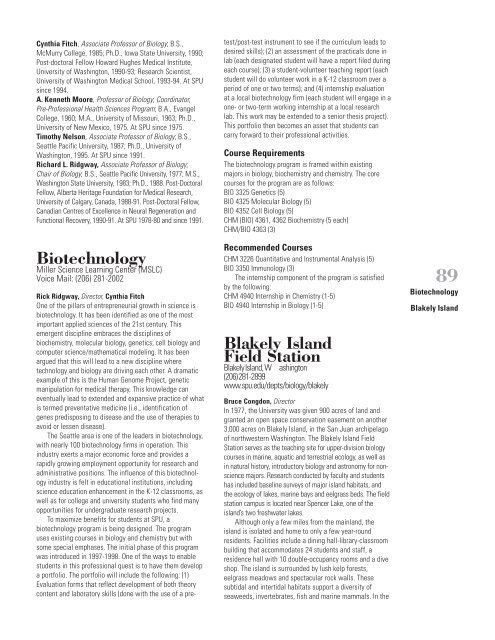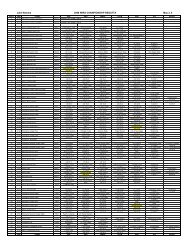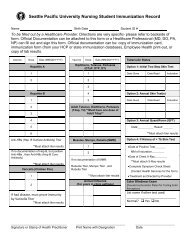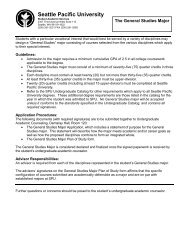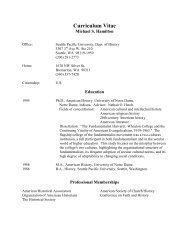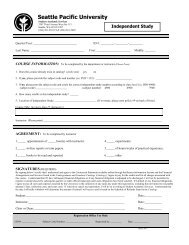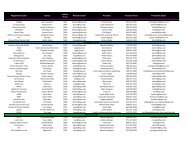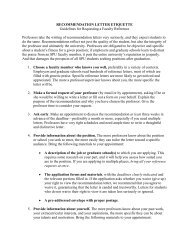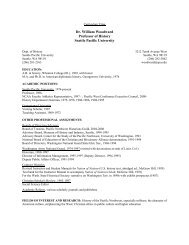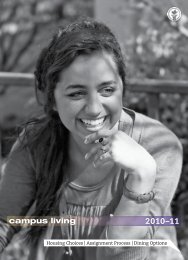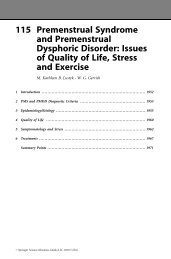Accounting Anthropology Art - Seattle Pacific University
Accounting Anthropology Art - Seattle Pacific University
Accounting Anthropology Art - Seattle Pacific University
Create successful ePaper yourself
Turn your PDF publications into a flip-book with our unique Google optimized e-Paper software.
Cynthia Fitch, Associate Professor of Biology; B.S.,<br />
McMurry College, 1985; Ph.D., Iowa State <strong>University</strong>, 1990;<br />
Post-doctoral Fellow Howard Hughes Medical Institute,<br />
<strong>University</strong> of Washington, 1990-93; Research Scientist,<br />
<strong>University</strong> of Washington Medical School, 1993-94. At SPU<br />
since 1994.<br />
A. Kenneth Moore, Professor of Biology; Coordinator,<br />
Pre-Professional Health Sciences Program; B.A., Evangel<br />
College, 1960; M.A., <strong>University</strong> of Missouri, 1963; Ph.D.,<br />
<strong>University</strong> of New Mexico, 1975. At SPU since 1975.<br />
Timothy Nelson, Associate Professor of Biology; B.S.,<br />
<strong>Seattle</strong> <strong>Pacific</strong> <strong>University</strong>, 1987; Ph.D., <strong>University</strong> of<br />
Washington, 1995. At SPU since 1991.<br />
Richard L. Ridgway, Associate Professor of Biology;<br />
Chair of Biology; B.S., <strong>Seattle</strong> <strong>Pacific</strong> <strong>University</strong>, 1977; M.S.,<br />
Washington State <strong>University</strong>, 1983; Ph.D., 1988. Post-Doctoral<br />
Fellow, Alberta Heritage Foundation for Medical Research,<br />
<strong>University</strong> of Calgary, Canada, 1988-91. Post-Doctoral Fellow,<br />
Canadian Centres of Excellence in Neural Regeneration and<br />
Functional Recovery, 1990-91. At SPU 1978-80 and since 1991.<br />
Biotechnology<br />
Miller Science Learning Center (MSLC)<br />
Voice Mail: (206) 281-2002<br />
Rick Ridgway, Director, Cynthia Fitch<br />
One of the pillars of entrepreneurial growth in science is<br />
biotechnology. It has been identified as one of the most<br />
important applied sciences of the 21st century. This<br />
emergent discipline embraces the disciplines of<br />
biochemistry, molecular biology, genetics, cell biology and<br />
computer science/mathematical modeling. It has been<br />
argued that this will lead to a new discipline where<br />
technology and biology are driving each other. A dramatic<br />
example of this is the Human Genome Project, genetic<br />
manipulation for medical therapy. This knowledge can<br />
eventually lead to extended and expansive practice of what<br />
is termed preventative medicine (i.e., identification of<br />
genes predisposing to disease and the use of therapies to<br />
avoid or lessen disease).<br />
The <strong>Seattle</strong> area is one of the leaders in biotechnology,<br />
with nearly 100 biotechnology firms in operation. This<br />
industry exerts a major economic force and provides a<br />
rapidly growing employment opportunity for research and<br />
administrative positions. The influence of this biotechnology<br />
industry is felt in educational institutions, including<br />
science education enhancement in the K-12 classrooms, as<br />
well as for college and university students who find many<br />
opportunities for undergraduate research projects.<br />
To maximize benefits for students at SPU, a<br />
biotechnology program is being designed. The program<br />
uses existing courses in biology and chemistry but with<br />
some special emphases. The initial phase of this program<br />
was introduced in 1997-1998. One of the ways to enable<br />
students in this professional quest is to have them develop<br />
a portfolio. The portfolio will include the following: (1)<br />
Evaluation forms that reflect development of both theory<br />
content and laboratory skills (done with the use of a pretest/post-test<br />
instrument to see if the curriculum leads to<br />
desired skills); (2) an assessment of the practicals done in<br />
lab (each designated student will have a report filed during<br />
each course); (3) a student-volunteer teaching report (each<br />
student will do volunteer work in a K-12 classroom over a<br />
period of one or two terms); and (4) internship evaluation<br />
at a local biotechnology firm (each student will engage in a<br />
one- or two-term working internship at a local research<br />
lab. This work may be extended to a senior thesis project).<br />
This portfolio then becomes an asset that students can<br />
carry forward to their professional activities.<br />
Course Requirements<br />
The biotechnology program is framed within existing<br />
majors in biology, biochemistry and chemistry. The core<br />
courses for the program are as follows:<br />
BIO 3325 Genetics (5)<br />
BIO 4325 Molecular Biology (5)<br />
BIO 4352 Cell Biology (5)<br />
CHM (BIO) 4361, 4362 Biochemistry (5 each)<br />
CHM/BIO 4363 (3)<br />
Recommended Courses<br />
CHM 3226 Quantitative and Instrumental Analysis (5)<br />
BIO 3350 Immunology (3)<br />
The internship component of the program is satisfied<br />
by the following:<br />
CHM 4940 Internship in Chemistry (1-5)<br />
BIO 4940 Internship in Biology (1-5)<br />
Blakely Island<br />
Field Station<br />
Blakely Island, W ashington<br />
(206) 281-2899<br />
www.spu.edu/depts/biology/blakely<br />
Bruce Congdon, Director<br />
In 1977, the <strong>University</strong> was given 900 acres of land and<br />
granted an open space conservation easement on another<br />
3,000 acres on Blakely Island, in the San Juan archipelago<br />
of northwestern Washington. The Blakely Island Field<br />
Station serves as the teaching site for upper-division biology<br />
courses in marine, aquatic and terrestrial ecology, as well as<br />
in natural history, introductory biology and astronomy for nonscience<br />
majors. Research conducted by faculty and students<br />
has included baseline surveys of major island habitats, and<br />
the ecology of lakes, marine bays and eelgrass beds. The field<br />
station campus is located near Spencer Lake, one of the<br />
island’s two freshwater lakes.<br />
Although only a few miles from the mainland, the<br />
island is isolated and home to only a few year-round<br />
residents. Facilities include a dining hall-library-classroom<br />
building that accommodates 24 students and staff, a<br />
residence hall with 10 double-occupancy rooms and a dive<br />
shop. The island is surrounded by lush kelp forests,<br />
eelgrass meadows and spectacular rock walls. These<br />
subtidal and intertidal habitats support a diversity of<br />
seaweeds, invertebrates, fish and marine mammals. In the<br />
89<br />
Biotechnology<br />
Blakely Island


